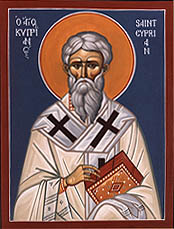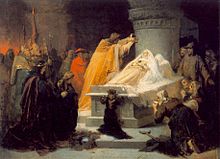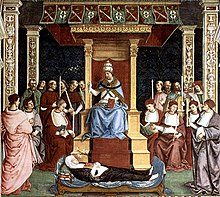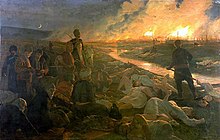Canonization

Canonization is the declaration of a deceased person as an officially recognized saint,[1] specifically, the official act of a Christian communion declaring a person worthy of public veneration and entering their name in the canon catalogue of saints,[2] or authorized list of that communion's recognized saints.[3][4]
Catholic Church

Canonization is a papal declaration that the Catholic faithful may venerate a particular deceased member of the church. Popes began making such decrees in the tenth century. Up to that point, the local bishops governed the veneration of holy men and women within their own dioceses; and there may have been, for any particular saint, no formal decree at all. In subsequent centuries, the procedures became increasingly regularized and the Popes began restricting to themselves the right to declare someone a Catholic saint. In contemporary usage, the term is understood to refer to the act by which any Christian church declares that a person who has died is a saint, upon which declaration the person is included in the list of recognized saints, called the "canon".[5]
Biblical roots
In the Roman Martyrology, the following entry is given for the
Historical development
The Roman Rite's Canon of the Mass contains only the names of apostles and martyrs, along with that of the Blessed Virgin Mary and, since 1962, that of Saint Joseph her spouse.
By the fourth century, however, "confessors"—people who had confessed their faith not by dying but by word and life—began to be venerated publicly. Examples of such people are Saint Hilarion and Saint Ephrem the Syrian in the East, and Saint Martin of Tours and Saint Hilary of Poitiers in the West. Their names were inserted in the diptychs, the lists of saints explicitly venerated in the liturgy, and their tombs were honoured in like manner as those of the martyrs. Since the witness of their lives was not as unequivocal as that of the martyrs, they were venerated publicly only with the approval by the local bishop. This process is often referred to as "local canonization".[9]
This approval was required even for veneration of a reputed martyr. In his history of the
Though not "canonizations" in the narrow sense, acts of formal recognition, such as the erection of an altar over the saint's tomb or transferring the saint's relics to a church, were preceded by formal inquiries into the sanctity of the person's life and the miracles attributed to that person's intercession.
Such acts of recognition of a saint were authoritative, in the strict sense, only for the diocese or ecclesiastical province for which they were issued, but with the spread of the fame of a saint, were often accepted elsewhere also.
Nature
In the
In the Catholic Church, canonization is a decree that allows universal veneration of the saint. For permission to venerate merely locally, only beatification is needed.[10]
Procedure prior to reservation to the Apostolic See

For several centuries the bishops, or in some places only the primates and patriarchs,[11] could grant martyrs and confessors public ecclesiastical honor; such honor, however, was always decreed only for the local territory of which the grantors had jurisdiction. Only acceptance of the cultus by the Pope made the cultus universal, because he alone can rule the universal Catholic Church.[12] Abuses, however, crept into this discipline, due as well to indiscretions of popular fervor as to the negligence of some bishops in inquiring into the lives of those whom they permitted to be honoured as saints.
In the Medieval West, the
Thereafter, recourse to the judgment of the
Exclusive reservation to the Apostolic See
However, the procedure initiated by the decretal of
Procedure from 1734 to 1738 to 1983
In his De Servorum Dei beatificatione et de Beatorum canonizatione of five volumes the eminent canonist Prospero Lambertini (1675–1758), who later became
Since 1983
The
Candidates for canonization undergo the following process:
- act of heroic charity for others.by performing a miracle for which the Venerable interceded. Presently, these miracles are almost always miraculous cures of infirmity, because these are the easiest to judge given the Church's evidentiary requirements for miracles; e.g., a patient was sick with an illness for which no cure was known; prayers were directed to the Venerable; the patient was cured; the cure was spontaneous, instantaneous, complete, and enduring; and physicians cannot discover any natural explanation for the cure.
- For a non-martyr, all of them being denominated "confessors" because they "confessed", i.e., bore witness to the Faith by how they lived, proof is required of the occurrence of a miracle through the intercession of the Venerable; that is, that God granted a sign that the person is enjoying the beatific vision
Canonization is a statement of the Church that the person certainly enjoys the beatific vision of
Although recognition of sainthood by the
Regarding the
Equipollent canonization
Popes have several times permitted to the universal Church, without executing the ordinary judicial process of canonization described above, the veneration as a saint, the "cultus" of one long venerated as such locally. This act of a Pope is denominated "equipollent" or "equivalent canonization"[28] and "confirmation of cultus".[29] In such cases, there is no need to have a miracle attributed to the saint to allow their canonization.[28] According to the rules Pope Benedict XIV (regnat 17 August 1740 – 3 May 1758) instituted, there are three conditions for an equipollent canonization: (1) existence of an ancient cultus of the person, (2) a general and constant attestation to the virtues or martyrdom of the person by credible historians, and (3) uninterrupted fame of the person as a worker of miracles.
Protestant denominations
The majority of Protestant denominations do not formally recognize saints because the Bible uses the term in a way that suggests all Christians are saints. However, some denominations do, as shown below.
Anglican Communion
The
United Methodist Church
The
Eastern Orthodox Church
This section needs expansion. You can help by adding to it. (July 2020) |

Various terms are used for canonization by the
The Orthodox Church in America, an Eastern Orthodox Church partly recognized as autocephalous, uses the term "glorification" for the official recognition of a person as a saint.[39]
Oriental Orthodox Church
This section needs expansion. You can help by adding to it. (July 2020) |
Within the Armenian Apostolic Church, part of Oriental Orthodoxy, there had been discussions since the 1980s about canonizing the victims of the Armenian genocide.[40] On 23 April 2015, all of the victims of the genocide were canonized.[41][42][43]
See also
- List of canonizations
- List of saints
- List of early Christian saints
- Decanonization
Notes
- ^ "canonize". Dictionary. Merriam-Webster. Retrieved 6 July 2020.
- ^ Charles Annandale. The Imperial Dictionary of the English Language, Volume 1; 1905. P. 386. Canon – A catalogue of saints acknowledged and canonized in the Roman Catholic Church.
- ^ CANON // Catholic Encyclopedia, Volume 3; 1913. – P. 255–256. – The name Canon (κανών) means a norm or rule; and it is used for various objects, such as the Canon of Holy Scripture, canons of Councils, the official list of saints' names (whence "canonization"), and the canon or list of clerks who serve a certain church, from which they themselves are called canons (canonici).
- ^ "Canonization". Encyclopædia Britannica. Retrieved 6 July 2020.
- ISSN 1478-0542.
- ^ "Laudate Dominum – Roman Martyrology – March".
- ^ Clark, John (3 April 2015). "Canonized from the Cross: How St Dismas Shows it's Never Too Late..." Seton Magazine. Retrieved 1 March 2020.
- ^ Kemp (1948).
- ^ For the history of such canonization, see Kemp.[8]
- ^ "Beatification, in the present discipline, differs from canonization in this: that the former implies (1) a locally restricted, not a universal, permission to venerate, which is (2) a mere permission, and no precept; while canonization implies a universal precept" (Beccari, Camillo. "Beatification and Canonization". The Catholic Encyclopedia. Vol. 2. New York: Robert Appleton Company, 1907. Accessed 27 May 2009.).
- ^ August., Brevic. Collat. cum Donatistis, III, 13, no. 25 in PL, XLIII, 628.
- ^ Gonzalez Tellez, Comm. Perpet. in singulos textus libr. Decr., III, xlv, in Cap. 1, De reliquiis et vener. Sanct.
- S2CID 159681002.
- ^ a b "William Smith and Samuel Cheetham, A Dictionary of Christian Antiquities (Murray, 1875)". Boston: Little. p. 283. Retrieved 4 October 2014.
- ^ "Pope Alexander III". Archived from the original on 15 October 2013. Retrieved 4 October 2014.
- ^ Pope Gregory IX, Decretales, 3, "De reliquiis et veneratione sanctorum". It is alternatively quoted as follows: "For the future you will not presume to pay him reverence, as, even though miracles were worked through him, it would not allow you to revere him as a saint unless with the authority of the Roman Church". (C. 1, tit. cit., X, III, xlv.)
- ^ St. Robert Bellarmine, De Eccles. Triumph., I, 8.
- ^ "Aimable Musoni, 'Saints without Borders'" (PDF). pp. 9–10. Archived from the original (PDF) on 11 February 2020. Retrieved 12 October 2013.
- ^ a b "Divinus Perfectionis Magister". The Holy See. Retrieved 4 October 2014.
- ^ "Devil's Advocate Is Puglia: 'It will test the virtues of aspiring saints', la Republica". 5 November 2012.
- ^ Pope John Paul II, Divinus Perfectionis Magister (25 January 1983), Art. 1, Sec. 1.
- ^ Pietro Cardinal Palazzini, Norms to be observed in inquiries made by bishops in the causes of saints, 1983 Archived 22 October 2006 at the Wayback Machine, §9(a).
- ^ Mother Teresa of Calcutta (1910–1997), Biography, Office of Papal Liturgical Celebrations, Internet Office of the Holy See
- ^ "Sister Lucia's Beatification Process to Begin". ZENIT – The World Seen from Rome. Archived from the original on 27 September 2012. Retrieved 4 October 2014.
- ^ Doctrinal Commentary on the Concluding Formula of the Professio Fidei, by Cardinal Joseph Ratzinger (later Pope Benedict XVI), Congregation for the Doctrine of the Faith.
- ^ "Beatification and Canonization", The Catholic Encyclopedia, Vol. 2. New York: Robert Appleton Company, 1907. p. 366.
- ^ a b EWTN. "Pope Francis declares blind 14th-century lay Dominican a saint". CNA. Retrieved 24 April 2021.
- ^ "Catholic Encyclopedia: Beatification and Canonization". www.newadvent.org. Archived from the original on 16 January 2000. Retrieved 24 April 2021.
Those proposed as coming under the definition of cases excepted (casus excepti) by Urban VIII are treated in another way. In such cases it must be proved that an immemorial public veneration (at least for 100 years before the promulgation, in 1640, of the decrees of Urban VIII) has been paid the servant of God, whether confessor or martyr. Such cause is proposed under the title of "confirmation of veneration" (de confirmatione cultus); it is dealt with in an ordinary meeting of the Congregation of Rites.
- ISBN 9780191642449.
In 1660 the convocations of Canterbury and York canonized King Charles.
- Dallas News. Retrieved 4 May 2018.
- ^ Mulenga, Maidstone (1 May 2012). "United Methodists declare MLK Jr. a modern-day martyr". United Methodist Church. Archived from the original on 23 September 2017. Retrieved 4 May 2018.
- ^ Αγ. Χρυσόστομος Σμύρνης Archived 21 July 2011 at archive.today. Municipality of Triglia. Retrieved: 7 September 2012.
- ^ (in Greek) Κων/τίνος Β. Χιώλος. "Ο μαρτυρικός θάνατος του Μητροπολίτου Σμύρνης Archived 12 September 2017 at the Wayback Machine". Δημοσια Κεντρικη Βιβλιοθηκη Σερρων. Τετάρτη, 13 Σεπτεμβρίου 2006.
- ^ "Почему был канонизирован Николай Второй?" by Protodeacon Andrey Kuraev at Pravmir.ru (17 July 2009)
- ^ ""Прославление святых – это не дело узкого круга специалистов, это дело всей Церкви" by Julija Birjukova at Pravmir.ru (9 Dec. 2013)".
- Protopresbyter Michael Pomazansky
- Dictionary of Modern Greek, Athens: Lexicology Centre, 1998, p. 53.
- ^ "The Glorification of Saints in the Orthodox Church" Archived 8 April 2016 at the Wayback Machine by Fr. Joseph Frawley
- ^ Roberta R. Ervine, Worship Traditions in Armenia and the Neighboring Christian East, St Vladimir's Seminary Press, 2006, p. 346 n. 17.
- ^ Davlashyan, Naira. "Armenian Church makes saints of 1.5 million genocide victims". Yahoo News. Retrieved 23 April 2015.
- ^ "Armenian Genocide victims canonized in Holy Etchmiadzin". Panarmenian.Net. Retrieved 23 April 2015.
- ^ "Canonized: Armenian Church proclaims collective martyrdom of Genocide victims – Genocide". ArmeniaNow.com. Archived from the original on 29 July 2020. Retrieved 23 April 2015.
References
- Kemp, Eric Waldram (1948), Canonization and Authority in the Western Church, Oxford: Oxford University Press
External links
 Texts on Wikisource:
Texts on Wikisource:
- "Canonization", Encyclopædia Britannica, vol. 5 (9th ed.), 1878, pp. 22–23
- Delehaye, Hippolyte (1911), "Canonization", Encyclopædia Britannica, vol. 5 (11th ed.), pp. 192–193
- Beccari, Camillo (1907). "Beatification and Canonization". Catholic Encyclopedia. Vol. 2.
Catholic Church
- Divinus Perfectionis Magister – Apostolic Constitution of Pope John Paul II (English)
- Congregation for the Causes of Saints – Vatican Website
- Historical Sketch of Canonization – Friarsminor.org
